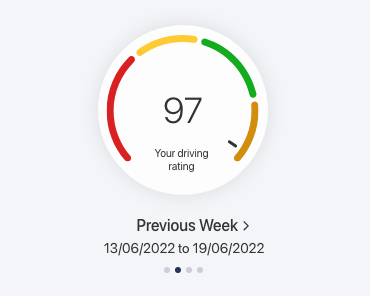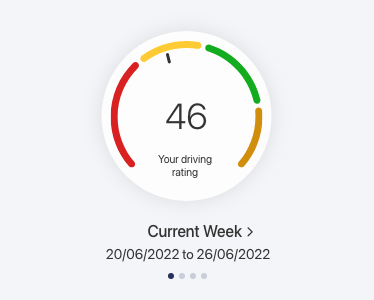What you can find in the app

- All your trips on a map with pins to show you where you could improve
- A weekly driver rating and breakdown of your driving behaviours
- Your reward points total and how to bank and redeem them
- Regular personalised messages about your driving
- Video content and coaching tips to help you improve your driver rating
What the app measures
The app measures:




Your driver rating
Unsafe driving (because of speeding above the legal limit, harsh acceleration or mobile phone use, for example) could result in a red rated week. If this happens, we’ll show you where you can improve and give you time to do this. If your seven-day driver rating doesn’t improve out of red, your policy could be cancelled. But we’ll send you reminders before this happens.
- Important - You’ll need to ensure you activate the Quotemehappy Connect App, pair the device and complete trips in the first 14 days of your policy
- Find out more about when we might cancel





Support to improve your driver rating
For a taste of the kind of help we can give, check out our top tips video, or videos on specific driving behaviours like speeding, braking, cornering and distracted driving.
Advanced training is known to make drivers 70% safer than other road users.
(Brunel University London 2006 : http://www.brunel.ac.uk/)
So here are some advanced driving tips that will help you become an even safer driver:
- Make safety the top priority for every trip - all of your decisions should put safety first
- Stay calm and focussed behind the wheel, avoiding decisions based on emotion will help you to react and drive much more safely
- Never blame other drivers for their mistakes on the road, control your vehicle safely, irrespective of other drivers behaviour
- Self-analysis helps you focus on improving how you drive. After each journey ask yourself…How safe was I? How did my driving affect others? How could I have been safer?
- Be aware of what is ahead of you and plan your decisions early. Slowing down sooner greatly improves safety
- Even if you are running late, safety must be your top priority, adjusting your speed to safely navigate any hazards
Let's make the UK's roads safer, together.
95% of all road accidents are due to driver error - with drivers either not seeing hazards, or driving into them too fast.
(https://www.rospa.com/rospaweb/docs/advice-services/road-safety/road-crashes-overview.pdf)
All hazards have the potential to be dangerous, so let’s take a look at the different types you may encounter.
Static hazards like a corner or road junction will be familiar and often easy to navigate, but moving hazards like a pedestrian or a moving vehicle are often unpredictable and need extra care.
When approaching a hazard it’s important to control your speed. Driving slower gives you more time to react and manoeuvre safely.
By staying focussed on your driving, you will improve your early hazard recognition and be safer on the road.
So here are some tips to remember:
- Develop your visual scanning of the road ahead to help locate and navigate hazards safely
- Create extra space in front of you on approach to hazards – this builds a ‘safety buffer’
- Plan your actions early and never drive into hazards too fast
Let's make the UK's roads safer, together.
You are four times more likely to be in a crash if you use your phone while driving and your reaction times are two times slower if you text and drive using a hands-free phone.
(https://www.think.gov.uk/themes/mobile-phones/" 2022)
Every time you take your eyes off the road you increase the risk.
Preparing for your drive is an easy way to reduce distractions.
Here are some simple tips that you can use right now:
- Set up your GPS and any music or podcasts before you start your engine
- Switch your phone to ‘do not disturb’ mode, so calls, texts and social media updates don’t distract you
- Let colleagues, friends or family know if you’re setting off on a long drive so they know not to get in touch unless absolutely necessary
- And don’t forget - never call someone if you think they could be driving
We can all help avoid distraction, so let's make the UK's roads safer, together.
Did you know that over 50% of all fatal crashes happen on country roads?
(https://www.brake.org.uk/get-involved/take-action/mybrake/knowledge-centre/road-design/rural-roads)
This is because rural roads are typically narrow, with frequent blind bends. Meaning drivers can easily lose control, often resulting in an accident.
Here are some tips on how to corner safely:
- On approach to a turn - check your mirrors so you know what’s behind you
- Then, if necessary, brake in a straight line ‘before the turn’
- Base your ‘corner entry speed on what you can see ahead’. The less you see ahead, the slower you must enter the turn
- You should always be able to “stop safely within the distance you can see to be clear ahead”. Always leave something in reserve – just in case
- Poor weather and road surface conditions make it more difficult to control your vehicle safely. So it is important to take extra care and navigate corners at a speed where you have more than enough distance to stop safely
Let's make the UK's roads safer, together.
The average stopping distance, for cars travelling at 30 miles per hour, is equivalent to six car lengths (Carbuyer September 2020: https://www.carbuyer.co.uk/tips-and-advice/147841/stopping-distances-explained). But drivers should consider other factors that could increase this further:
Let’s find out why that is …
At any given time your tires have an area of grip with the road the size of a small envelope.
The effectiveness of this contact can be affected by poor weather and road surfaces which play a crucial role in tire traction and braking performance.
Many rear end shunts are caused by braking in panic, as any drivers behind you won't have enough ‘space or time’ to stop…
Events like this are more frequent when drivers are following too closely and high speeds are involved.
The later a driver is forced to brake when approaching a hazardous situation, the more dangerous it becomes.
Here are some easy-to-use braking tips;
By braking early and progressively... you enhance safety and create ‘space and time’ to react. Plus, your brake lights signal to other drivers that you are slowing down.
On approach to corners / turns, brake in a straight line before the corner (braking in a turn is to be avoided).
Avoid hard braking by:
- Being observant
- Leaving plenty of space
- Keeping to a safe speed
Let's make the UK's roads safer, together.
Did you know that speeding was a major contributor in 27% of fatal collisions in 2020.
(https://www.rospa.com/road-safety/advice/drivers/speeding)
As well as breaking the law - speeding endangers both yourself and those around you.
Remaining focused on your speed at all times will ensure your safety is prioritised.
Here are some simple tips to help you manage your speed more safely:
- Ask yourself how often YOU speed? Then ask WHY you speed?
- When approaching hazards, it’s safer to be slightly slower, than too fast
- Remember, if you double your speed, you increase your braking and stopping distance by 4 times
- Don’t use running late as an excuse to speed – let safety be your reason not to
- Finally, constantly ask yourself... “Is my speed safe?” you will be more likely to make safe decisions and not increase the number of speed related deaths
Let's make the UK's roads safer, together.
What to do with the Quotemehappy Connect device

Got your device but not sure where to start? Learn how to set up the Quotemehappy Connect app and device.
Or find answers to your questions about the Quotemehappy Connect device.

